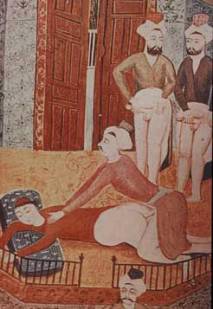The penetrated man is a symbol that opens a door to the unknown. The symbol of the Submissive posits a violation of Man’s authority and integrity.

Turkey, Male Group Scene, 19th century
In the Tomb of the Bulls, an Etruscan fresco from 530 B.C. decorates a doorway. It shows a man being anally penetrated by another man, while the couple is about to be gored by a charging bull. The wounded Christ is another doorway described in homoerotic terms in John 10:9 “I am the door, by me if any man enter in, he shall be saved, and shall go in and out….”
The submissive man is mocked in cultures around the world for abandoning the privileges of masculinity. Receptivity, flexibility, softness and inwardness characterize the man possessed of this attribute. The symbol speaks of allowing the unfolding world, rather than attempting to dominate others. In psychic terms, it speaks of allowing the unconscious, unintentional contents of both mind and culture. For men pinned down and pumped up by phallic masculinity, submission to anal penetration is a radical, transforming desire. Klaus Theweleit, writing of male fantasies, comments “Anal penetration comes to represent the opening of social prisons, admission into a hidden dungeon that guards the keys to the recuperation of the revolutionary dimension of desire[1]. . . .”
Shadow: Surrender is a powerful way of being in the world. Paradoxically, queer also points us in an opposite direction, to the importance of anger. Too often, we submit to homophobia; we fail to fight the violence that threatens us. We may find a queer balance by allowing our identity to be informed by the seeming opposites of both gay male submission and the rage for justice associated with angry lesbians.
Related Figures and Attributes: Effeminate Man, Angry, Androgyne
For more writing on this symbol, see these chapters of Orientation: Mapping Queer Meanings: Effeminacy, Surfaces, Rage, Darkness
[1] Klaus Theweleit, Male Fantasies, trans Chris Turner and Erica Carter, Cambridge: polity Press, 1989, Volume 2 p 138, quoted by Murray Healy, 1996


